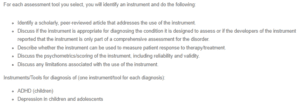Anxiety and Related Disorders
DSM #1: ADHD in Children
Instrument: Conners Comprehensive Behavior Rating Scale (CBRS).
CBRS is a comprehensive assessment instrument for assessing behavioral, academic, and social issues affecting young children. It applies to persons between the ages of 6 and 18. CBRS assists in the diagnosis of ADHD. It is part of the comprehensive assessment and diagnosis of this disorder. This tool provides a multi-content scale that scores individuals based on manifestations such as academic difficulties, aggressive behaviors, social problems, impulsivity, and other symptoms suggestive of ADHD.
Article: Conners Comprehensive Behavior Rating Scales
Appropriateness for Dx: The CBRS tool maintains appropriateness in the diagnosis of ADHD. This tool can be used to distinguish individuals with ADHD from the rest of the population. The items on this tool score individuals based on how they manifest symptoms suggestive of ADHD as detailed in the diagnostic and statistical manual for mental health disorders.
Response to Therapy/Treatment: Findings from this instrument are suggestive of the presence and severity of ADHD symptoms. It is thus appropriate for determining individuals’ responses to therapy.
Psychometrics: The reliability and validity analysis of CRBS revealed that it has high internal consistency. Rzepa et al. (2018) note that, with Cronbach’s alpha values of between .69 and .97, CBRS is one of the most reliable assessment instruments available for the diagnosis of ADHD. This tool also has excellent test-retest correlations and temporal stability.
Limitations: With a validity of only 78%, CBRS cannot be used solely in the diagnosis of ADHD. This tool is also based on subjective responses given by individuals and may be inaccurate when symptoms are inaccurately represented.
Journal Discussion from instructions: The journal defines the CBRS tool and details its utility in the comprehensive management of ADHD in children. CBRS is centered on the provisions of the DSM related to the diagnostic features of ADHD (Rzepa et al., 2018). It is a highly accurate tool that can be used to distinguish ADHD from other mental health disorders, such as generalized anxiety disorder.
DSM: #2: Depression in Children and Adolescents
Instrument: The Patient Health Questionnaire (PHQ-9) is a diagnostic instrument used in the comprehensive management of depression for all ages. It is adapted from the PHQ-9 instrument. This tool measures the severity of depressive symptoms, with a scale rating denoting mild, moderate, and severe disease. It is a nine-item tool that scores each item based on the client’s responses and subjective and objective findings.
Article: Accuracy of Patient Health Questionnaire-9 (PHQ-9) for screening to detect major depression: Individual participant data meta-analysis
Appropriateness for Dx: PHQ-9 is appropriate for diagnosing depression in persons aged between 11 and 17. This tool is centered on the defined manifestations of major depressive disorder detailed in the diagnostic manual for mental health disorders. Findings not only demonstrate the presence of depressive symptoms but also the severity of these symptoms.
Response to Therapy/Treatment: PHQ-9 scores depressive symptoms on a scale corresponding to their severity. Higher scores are indicative of a severe disease. This tool can be used to assess response to anti-depressive therapies. A good prognosis of the disease will be noted by decreasing scores, while a poor prognosis of depression is denoted by higher scores than the baseline scores.
Psychometrics: PHQ-9 is highly sensitive and specific. With sensitivity and specificity scores of 88%, this tool is highly effective in diagnosing major depressive disorders in children and adolescents. This tool also has a high internal consistency. Kaggwa et al. (2022) note that PHQ-9 is an adequate, robust, and interpretable tool with excellent consistency; thus, it is reliable. It also has excellent test-retest correlations.
Limitations: Despite its excellent validity and reliability, PHQ-9 has a relatively low correlation of somatic indicators of depressive disorders. This may lower the tool’s overall accuracy and efficacy in monitoring depressive clients. It is also very limited in detecting other depressive disorders other than major depressive disorder. This can lead to misdiagnosis.
Journal Discussion from instructions: The study sought to determine the accuracy of PHQ-9 in screening for and detecting depression in children and adolescents. PHQ-9 maintains accuracy and sensitivity in assessing the severity of depressive symptoms and detecting their presence (Levis et al., 2019). It can thus be used as part of the comprehensive management of the disease.
References
Kaggwa, M. M., Najjuka, S. M., Ashaba, S., & Mamun, M. A. (2022). Psychometrics of the Patient Health Questionnaire (PHQ-9) in Uganda: A Systematic Review. Frontiers in Psychiatry, 13. https://doi.org/10.3389/fpsyt.2022.781095
Levis, B., Benedetti, A., & Thombs, B. D. (2019). Accuracy of Patient Health Questionnaire-9 (PHQ-9) for screening to detect major depression: individual participant data meta-analysis. BMJ, l1476. https://doi.org/10.1136/bmj.l1476
Rzepa, S. R., Conners, C. K., Pitkanen, J., & Mears, S. (2018). Conners Comprehensive Behavior Rating ScalesTM. Encyclopedia of Clinical Neuropsychology, 925–928. https://doi.org/10.1007/978-3-319-57111-9_1536
ORDER A PLAGIARISM-FREE PAPER HERE
We’ll write everything from scratch
Question

Anxiety and Related Disorders – ADHD in Children
For each assessment tool you select, you will identify an instrument and do the following:
- Identify a scholarly, peer-reviewed article that addresses the use of the instrument.
- Discuss if the instrument is appropriate for diagnosing the condition it is designed to assess or if the developers of the instrument reported that the instrument is only part of a comprehensive assessment for the disorder.
- Describe whether the instrument can be used to measure patient response to therapy/treatment.
- Discuss the psychometrics/scoring of the instrument, including reliability and validity.
- Discuss any limitations associated with the use of the instrument.
Instruments/Tools for diagnosis of (one instrument/tool for each diagnosis):
- ADHD (children)
- Depression in children and adolescents


